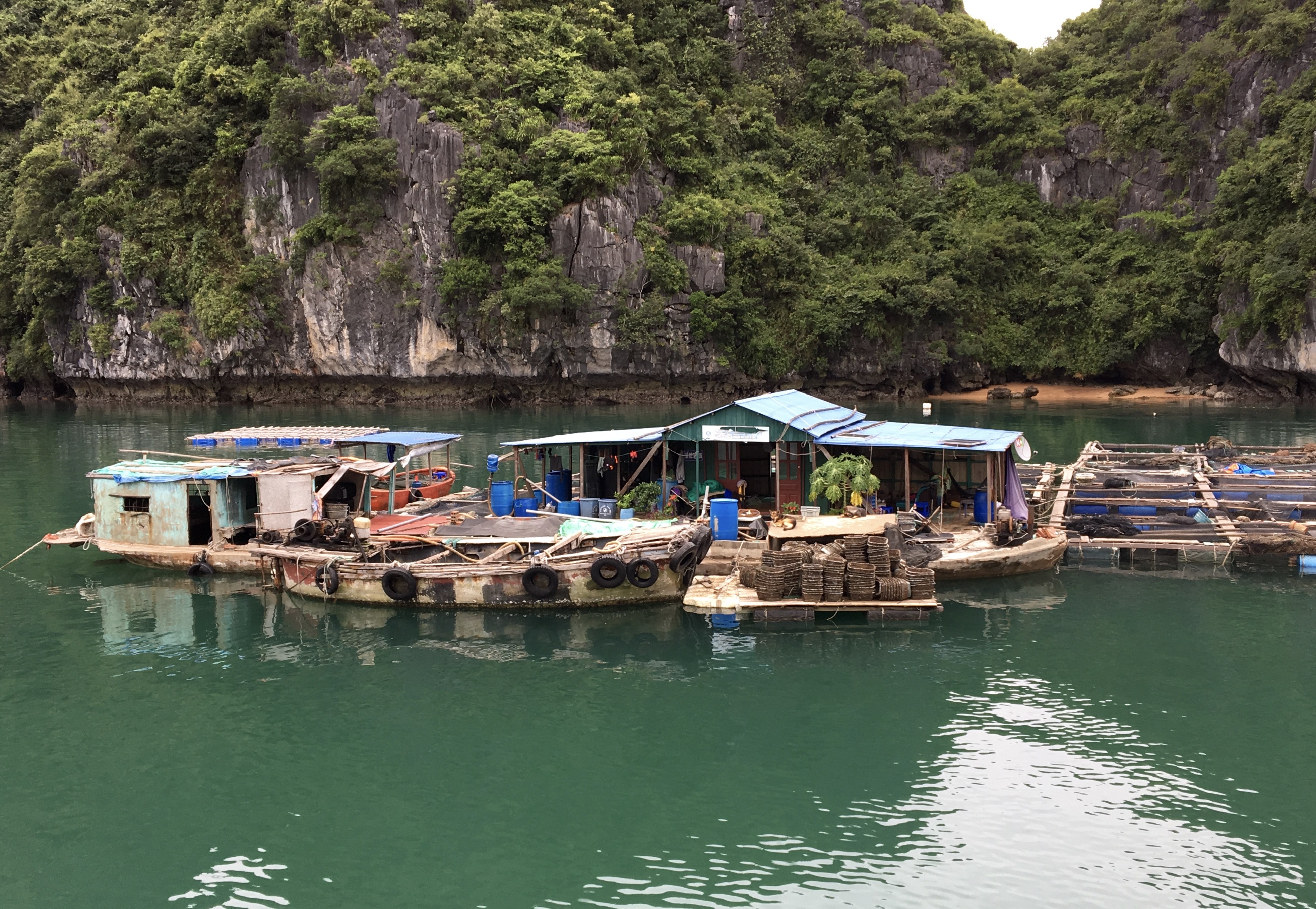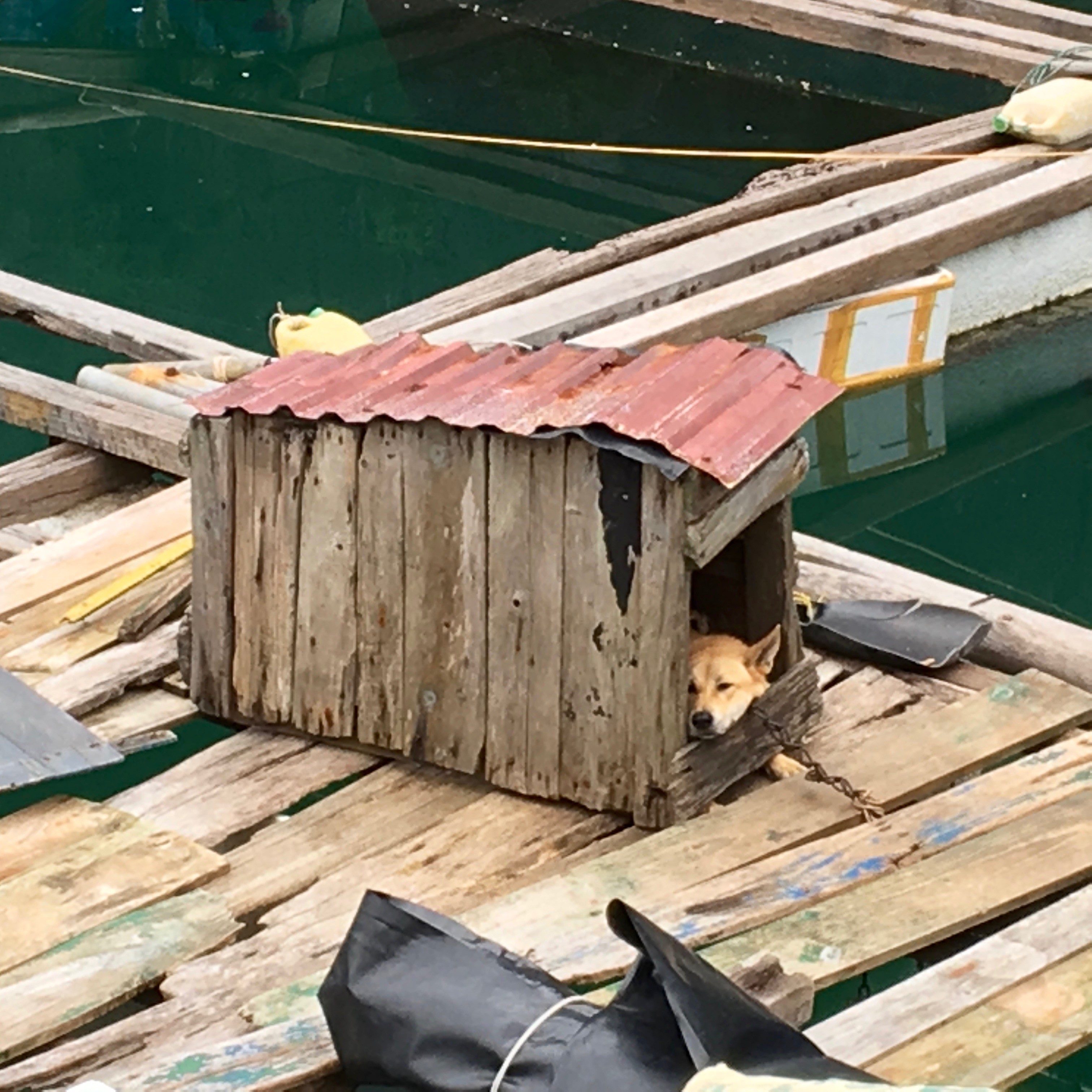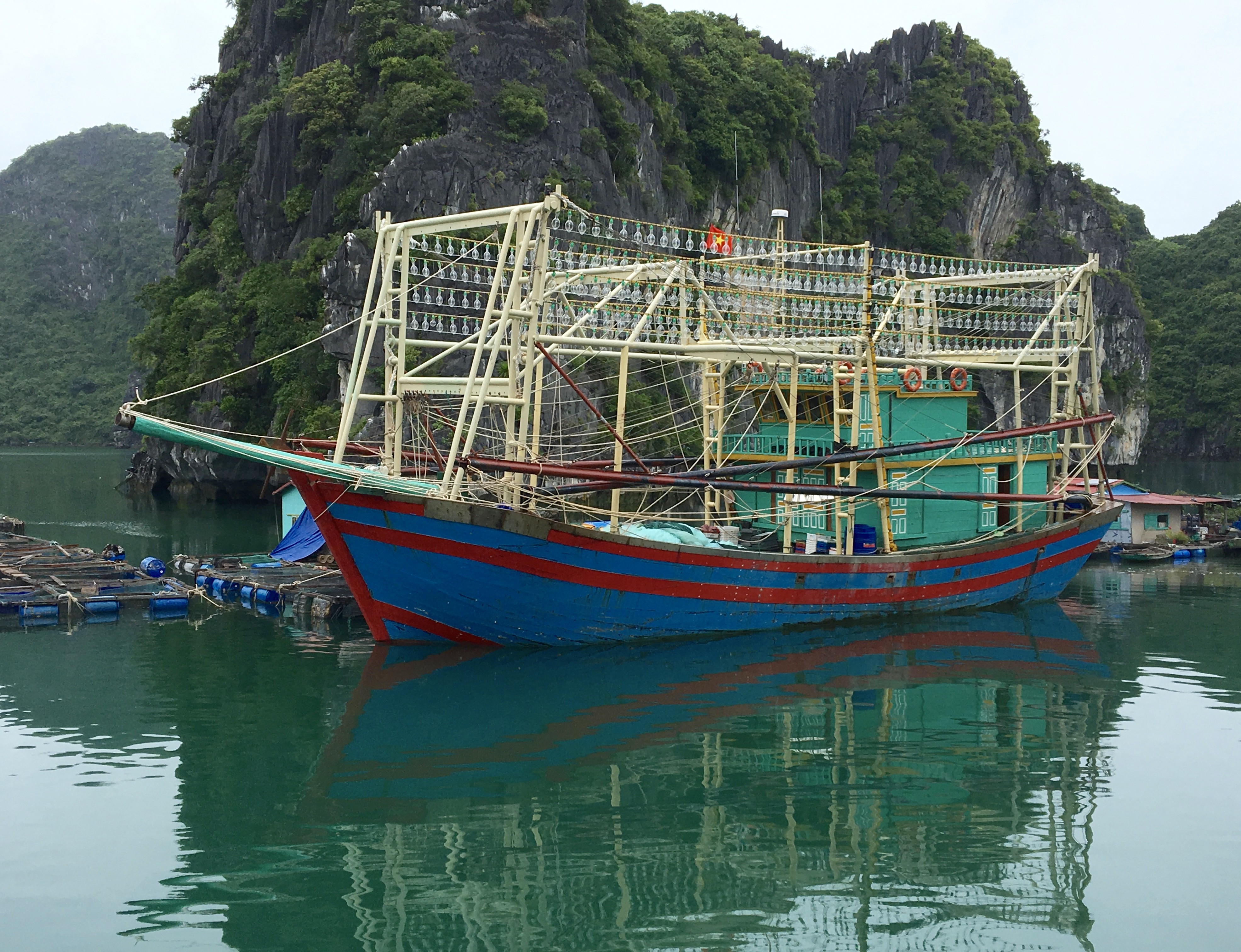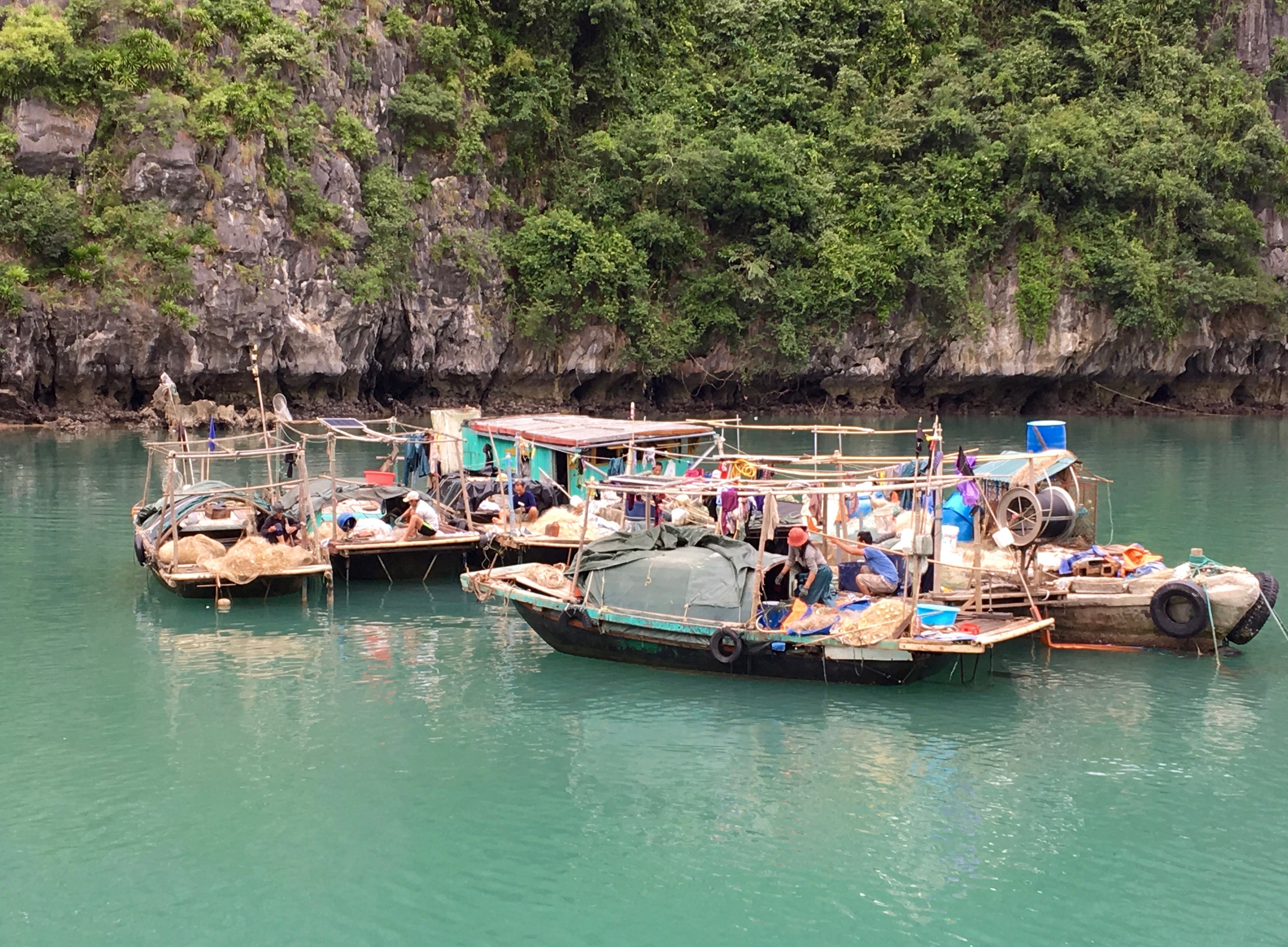Are you curious about the livelihoods of the people who call Cat Ba Island home? The stunning landscapes of Cat Ba, a jewel in Vietnam’s tourism crown, are not just a haven for travelers but also a source of life for its inhabitants. At SIXT.VN, we understand that exploring a destination means understanding its people. Let’s delve into the heart of Cat Ba and uncover the fascinating ways locals sustain their lives, balancing tradition with the opportunities of a growing tourism industry, all while enjoying a memorable Vietnamese vacation.
1. What Are the Primary Occupations on Cat Ba Island?
The primary occupations on Cat Ba Island are tourism and fishing, which significantly contribute to the local economy. Cat Ba Island’s economy thrives on the dual pillars of tourism and fishing, each interwoven with the island’s unique character and natural resources. Fishing, steeped in tradition, remains a fundamental source of livelihood for many families, while the burgeoning tourism sector offers diverse opportunities, from hospitality to guiding and transportation. As travel experts, SIXT.VN can help you experience both sides of Cat Ba, offering unique tours and insights into the local culture.
1.1 How Does Fishing Contribute to the Local Economy?
Fishing contributes to the local economy by providing food, income, and cultural identity. According to the General Statistics Office of Vietnam, the fishing industry accounts for a significant portion of the island’s income, particularly for those living in floating villages. The practice of fishing, deeply rooted in the local culture, sustains families and preserves a traditional way of life.
1.1.1 What Types of Fishing Are Common in Cat Ba?
Common types of fishing in Cat Ba include traditional net fishing, squid fishing, and aquaculture in floating farms. Traditional net fishing, often conducted by families, involves casting nets in the bay and relying on generational knowledge of tides and fish migration patterns. Squid fishing, a nighttime activity, uses bright lights to attract squid, creating a mesmerizing spectacle on the water. Aquaculture, or fish farming, has also gained prominence, with locals raising fish in floating pens, ensuring a stable supply for local markets and restaurants.
1.1.2 What Challenges Do Fishermen Face in Cat Ba?
Fishermen face challenges such as overfishing, pollution, and increasingly unpredictable weather patterns. Overfishing has depleted fish stocks in some areas, making it harder for fishermen to maintain their catch. Pollution, stemming from both land and sea, threatens the health of marine ecosystems, impacting fish populations and the quality of the catch. Increasingly unpredictable weather patterns, potentially linked to climate change, pose risks to fishermen venturing out to sea.
1.2 How Has Tourism Impacted the Livelihoods on Cat Ba Island?
Tourism has greatly impacted livelihoods on Cat Ba Island, creating new economic opportunities but also posing challenges. The Vietnam National Administration of Tourism reports a steady increase in tourist arrivals to Cat Ba, transforming the island’s economic landscape. While it has brought prosperity to many, there are also concerns about sustainability and the preservation of local culture.
1.2.1 What Tourism-Related Jobs Are Available on Cat Ba?
Tourism-related jobs available on Cat Ba range from hotel staff and tour guides to transportation providers and restaurant owners. The hospitality sector has seen significant growth, with numerous hotels and guesthouses offering employment opportunities. Tour guides are in high demand, providing visitors with insights into the island’s history, culture, and natural beauty. Transportation providers, including taxi drivers and boat operators, facilitate movement around the island and to nearby attractions. Restaurant owners and staff cater to the culinary needs of tourists, offering a taste of local cuisine and international dishes.
1.2.2 How Can Locals Benefit from Tourism?
Locals can benefit from tourism through direct employment, business opportunities, and the preservation of local culture and traditions. Direct employment in hotels, restaurants, and tour companies provides a steady income for many families. Business opportunities, such as souvenir shops and local craft stalls, allow locals to showcase their skills and products. Tourism also promotes the preservation of local culture and traditions, as visitors are keen to experience authentic aspects of island life.
 Floating House Cat Ba Island Vietnam
Floating House Cat Ba Island Vietnam
2. What Is Life Like in Cat Ba’s Floating Villages?
Life in Cat Ba’s floating villages is a unique blend of tradition and adaptation, with families living and working on the water. These villages, often nestled in sheltered bays, are home to communities that have traditionally relied on fishing for their livelihoods. While life can be challenging, it also fosters a strong sense of community and resilience. SIXT.VN offers tours that respectfully introduce you to these unique communities, providing insights into their daily lives.
2.1 How Are Floating Villages Constructed?
Floating villages are constructed using buoyant platforms made of wood, bamboo, and plastic barrels, supporting homes and aquaculture pens. The construction of these villages demonstrates ingenuity and adaptability, using locally available materials to create stable and functional living spaces. Homes are typically simple structures, often made of wood or corrugated iron, designed to withstand the elements.
2.2 What Are the Daily Routines in Floating Villages?
Daily routines in floating villages revolve around fishing, aquaculture, and tending to household chores on the water. Fishing remains a primary activity, with families venturing out to sea to catch fish or tend to their aquaculture pens. Children often travel by boat to attend schools on Cat Ba Island, while adults engage in various tasks, such as repairing nets, maintaining their homes, and trading with passing boats.
2.3 How Do Floating Villages Adapt to Environmental Challenges?
Floating villages adapt to environmental challenges like typhoons and pollution through community cooperation and sustainable practices. During typhoons, residents secure their homes and boats, often seeking shelter in protected bays or harbors. Community cooperation is essential for sharing resources and providing assistance during emergencies. Sustainable practices, such as waste management and responsible fishing, are increasingly promoted to mitigate the impact of pollution and protect the marine environment.
3. How Is Cat Ba Balancing Tourism and Traditional Livelihoods?
Cat Ba is balancing tourism and traditional livelihoods by implementing sustainable tourism practices and supporting local communities. Balancing the benefits of tourism with the need to preserve traditional livelihoods and protect the environment requires careful planning and community involvement. SIXT.VN is committed to promoting responsible tourism, ensuring that your visit contributes positively to the local community and environment.
3.1 What Sustainable Tourism Initiatives Are in Place?
Sustainable tourism initiatives in place include waste management programs, eco-tourism tours, and support for local businesses. Waste management programs aim to reduce pollution by promoting recycling and responsible waste disposal. Eco-tourism tours focus on showcasing the island’s natural beauty while minimizing environmental impact. Support for local businesses, such as craft shops and restaurants, ensures that tourism revenue benefits the local community.
3.2 How Are Local Communities Involved in Tourism Planning?
Local communities are involved in tourism planning through consultations, workshops, and participation in decision-making processes. Consultations and workshops provide opportunities for residents to voice their opinions and concerns about tourism development. Participation in decision-making processes ensures that local knowledge and perspectives are considered in tourism planning.
3.3 What Regulations Are in Place to Protect the Environment?
Regulations in place to protect the environment include restrictions on fishing, waste disposal, and construction in protected areas. Restrictions on fishing aim to prevent overfishing and protect marine ecosystems. Waste disposal regulations prohibit the dumping of waste into the sea and promote responsible waste management. Construction restrictions in protected areas aim to preserve the island’s natural beauty and biodiversity.
 Cat Ba Island Dogs Protecting Floating Village
Cat Ba Island Dogs Protecting Floating Village
4. What Cultural Experiences Can Tourists Enjoy on Cat Ba?
Tourists can enjoy a variety of cultural experiences on Cat Ba, including visiting local markets, participating in traditional festivals, and learning about fishing practices. Immersing yourself in the local culture is an enriching way to experience the authentic side of Cat Ba. SIXT.VN offers curated tours that allow you to connect with local communities and gain a deeper understanding of their way of life.
4.1 Are There Local Markets Worth Visiting?
Yes, local markets in Cat Ba offer a vibrant glimpse into daily life, with fresh seafood, local produce, and handicrafts. Visiting these markets provides an opportunity to interact with locals, sample local delicacies, and purchase unique souvenirs. Cat Ba Town Market is a bustling hub where you can find a wide array of goods and experience the energy of local commerce.
4.2 What Traditional Festivals Are Celebrated on Cat Ba?
Traditional festivals celebrated on Cat Ba include the Cat Ba Island Festival, celebrating the island’s culture and history, and various fishing festivals. The Cat Ba Island Festival features cultural performances, traditional games, and food stalls, offering a lively celebration of the island’s heritage. Fishing festivals, often held to pray for a bountiful catch, involve traditional rituals and ceremonies.
4.3 Can Tourists Learn About Traditional Fishing Practices?
Tourists can learn about traditional fishing practices by joining fishing tours, visiting floating villages, and interacting with local fishermen. Fishing tours offer hands-on experience in traditional fishing methods, allowing you to learn about the tools and techniques used by local fishermen. Visiting floating villages provides an opportunity to witness the daily routines of fishing families and understand their connection to the sea. Interacting with local fishermen offers insights into their knowledge of the marine environment and their challenges in sustaining their livelihoods.
5. How Can I Responsibly Support the Local Economy on Cat Ba?
You can responsibly support the local economy on Cat Ba by choosing local businesses, participating in eco-friendly tours, and respecting local customs. Making conscious choices about where you spend your money can have a significant impact on the local community. SIXT.VN is committed to promoting responsible tourism, ensuring that your visit benefits the local economy and environment.
5.1 Should I Choose Local Businesses Over International Chains?
Yes, choosing local businesses over international chains ensures that your money stays within the community, supporting local families and entrepreneurs. Local businesses, such as family-run restaurants, guesthouses, and craft shops, offer unique products and services that reflect the island’s culture and traditions. By choosing these businesses, you contribute directly to the local economy.
5.2 Are Eco-Friendly Tours Readily Available?
Eco-friendly tours are available and focus on minimizing environmental impact and promoting sustainable practices. These tours often involve activities such as kayaking, hiking, and wildlife watching, with a focus on respecting the natural environment. Tour operators committed to eco-tourism prioritize conservation and educate visitors about responsible travel.
5.3 What Local Customs Should Tourists Respect?
Tourists should respect local customs by dressing modestly, asking permission before taking photos, and being mindful of noise levels. Dressing modestly, especially when visiting religious sites, shows respect for local traditions. Asking permission before taking photos of people or private property is a sign of courtesy. Being mindful of noise levels, particularly in residential areas, helps maintain a peaceful environment.
 Cat Ba Island Fishing Boat
Cat Ba Island Fishing Boat
6. What Are the Emerging Economic Opportunities for Cat Ba Locals?
Emerging economic opportunities for Cat Ba locals include sustainable aquaculture, eco-tourism, and digital entrepreneurship. As the island continues to develop, new avenues for economic growth are emerging, offering opportunities for locals to diversify their livelihoods and improve their quality of life. SIXT.VN is committed to supporting these emerging opportunities, helping to create a sustainable and prosperous future for Cat Ba.
6.1 Is Sustainable Aquaculture a Viable Option?
Sustainable aquaculture, which focuses on environmentally friendly fish farming practices, is a viable option for locals seeking to diversify their income. By adopting sustainable methods, such as using organic feed and minimizing pollution, aquaculture can provide a stable income while protecting the marine environment. Training programs and government support are available to help locals transition to sustainable aquaculture practices.
6.2 How Is Eco-Tourism Creating New Jobs?
Eco-tourism is creating new jobs in guiding, hospitality, and conservation, providing opportunities for locals to showcase their knowledge and skills. Eco-tourism guides lead tours that focus on the island’s natural beauty, educating visitors about the local flora and fauna. Hospitality jobs in eco-lodges and sustainable resorts provide employment opportunities in a growing sector. Conservation jobs involve protecting the island’s natural resources, ensuring the long-term sustainability of the tourism industry.
6.3 Can Locals Leverage Digital Entrepreneurship?
Locals can leverage digital entrepreneurship by selling handicrafts online, offering virtual tours, and providing digital marketing services to local businesses. Selling handicrafts online allows locals to reach a global market, showcasing their unique products and skills. Offering virtual tours provides an opportunity to share the island’s beauty and culture with those unable to visit in person. Providing digital marketing services to local businesses helps them reach a wider audience and attract more customers.
7. What Government Policies Support Livelihoods on Cat Ba?
Government policies support livelihoods on Cat Ba through subsidies, training programs, and infrastructure development. These policies aim to promote sustainable economic growth, improve the quality of life for local communities, and protect the island’s natural resources. SIXT.VN works closely with local authorities to ensure that our operations align with government policies and contribute to the island’s sustainable development.
7.1 Are There Subsidies for Fishermen and Farmers?
Yes, there are subsidies for fishermen and farmers aimed at supporting their livelihoods and promoting sustainable practices. Subsidies may include financial assistance for purchasing equipment, fuel, and seeds, as well as support for adopting sustainable farming and fishing methods. These subsidies help reduce the financial burden on local communities and encourage them to adopt practices that protect the environment.
7.2 What Training Programs Are Available?
Training programs are available to help locals develop skills in tourism, aquaculture, and other sectors, improving their employability and income potential. These programs may include vocational training in hospitality, language courses for tour guides, and technical training in sustainable aquaculture practices. By providing access to education and training, the government aims to empower local communities and create opportunities for economic advancement.
7.3 How Is Infrastructure Development Impacting Livelihoods?
Infrastructure development, such as improved roads, ports, and utilities, is impacting livelihoods by improving access to markets, services, and opportunities. Improved roads facilitate the transportation of goods and people, making it easier for locals to access markets and services. Upgraded ports enhance fishing and tourism activities, providing opportunities for economic growth. Reliable utilities, such as electricity and water, improve the quality of life and support business operations.
 Night Squid Fishing Cat Ba
Night Squid Fishing Cat Ba
8. What Role Do NGOs Play in Supporting Cat Ba Communities?
NGOs play a vital role in supporting Cat Ba communities through conservation projects, community development initiatives, and advocacy efforts. These organizations work to address various challenges, such as environmental degradation, poverty, and lack of access to education and healthcare. SIXT.VN partners with NGOs to support their initiatives and promote sustainable development on the island.
8.1 What Conservation Projects Are NGOs Involved In?
Conservation projects that NGOs are involved in include protecting endangered species, restoring degraded ecosystems, and promoting sustainable resource management. These projects may involve activities such as monitoring wildlife populations, planting trees, cleaning up beaches, and educating local communities about conservation. By protecting the island’s natural resources, NGOs help ensure the long-term sustainability of livelihoods and tourism.
8.2 What Community Development Initiatives Are Being Implemented?
Community development initiatives being implemented include providing access to education, healthcare, and clean water, as well as supporting small businesses and promoting gender equality. These initiatives aim to improve the quality of life for local communities and empower them to participate in economic and social development. By addressing basic needs and promoting empowerment, NGOs help create a more equitable and sustainable future for Cat Ba.
8.3 How Do NGOs Advocate for Local Communities?
NGOs advocate for local communities by raising awareness about their needs and rights, lobbying for policy changes, and providing legal assistance. They may work to ensure that local communities are consulted in development projects, that their land rights are protected, and that they have access to justice. By amplifying the voices of local communities, NGOs help ensure that their concerns are heard and addressed by decision-makers.
9. How Can Cat Ba Preserve Its Unique Cultural Identity?
Cat Ba can preserve its unique cultural identity by promoting traditional arts and crafts, celebrating local festivals, and teaching the younger generation about their heritage. Preserving cultural identity is essential for maintaining the island’s unique character and attracting visitors who are interested in authentic experiences. SIXT.VN supports these efforts by promoting cultural tourism and partnering with local communities to showcase their heritage.
9.1 Is There Focus On Promoting Traditional Arts and Crafts?
Yes, there is a focus on promoting traditional arts and crafts through workshops, exhibitions, and support for local artisans. These initiatives help preserve traditional skills and create economic opportunities for local communities. By showcasing traditional arts and crafts, Cat Ba can attract visitors who are interested in authentic cultural experiences and support the livelihoods of local artisans.
9.2 How Can Celebrating Local Festivals Help?
Celebrating local festivals can help by bringing communities together, promoting cultural pride, and attracting tourists who are interested in experiencing local traditions. Festivals provide opportunities for locals to showcase their music, dance, cuisine, and other cultural expressions. By celebrating these festivals, Cat Ba can strengthen community bonds, preserve cultural heritage, and attract visitors who are interested in authentic experiences.
9.3 How Important Is Teaching Younger Generations About Their Heritage?
Teaching younger generations about their heritage is crucial for ensuring the continuity of cultural traditions and values. By learning about their history, language, arts, and customs, young people can develop a sense of identity and pride in their heritage. Schools, families, and community organizations all play a role in transmitting cultural knowledge and skills to younger generations, ensuring that Cat Ba’s unique cultural identity is preserved for future generations.
 Cat Ba Fishing Boats
Cat Ba Fishing Boats
10. What Is the Future Outlook for Livelihoods on Cat Ba?
The future outlook for livelihoods on Cat Ba is promising, with opportunities for sustainable growth in tourism, aquaculture, and other sectors. By embracing sustainable practices, investing in education and training, and promoting cultural preservation, Cat Ba can create a prosperous and equitable future for its communities. SIXT.VN is committed to supporting these efforts and helping to create a sustainable and vibrant future for Cat Ba.
10.1 What Trends Are Shaping the Future of Tourism?
Trends shaping the future of tourism include a growing demand for sustainable and authentic experiences, the rise of digital travel planning, and the increasing importance of responsible tourism. Tourists are increasingly seeking experiences that are environmentally friendly, culturally sensitive, and beneficial to local communities. Digital travel planning is becoming more prevalent, with travelers using online platforms to research and book their trips. Responsible tourism is gaining importance, with travelers seeking to minimize their environmental impact and support local economies.
10.2 How Can Aquaculture Be Developed Sustainably?
Aquaculture can be developed sustainably by adopting environmentally friendly practices, such as using organic feed, minimizing pollution, and protecting biodiversity. Sustainable aquaculture can provide a stable source of income for local communities while protecting the marine environment. By investing in research and development, promoting best practices, and providing training and support to local farmers, Cat Ba can develop a sustainable aquaculture industry that benefits both the economy and the environment.
10.3 What Steps Can Be Taken to Ensure Equitable Growth?
Steps that can be taken to ensure equitable growth include investing in education and training, promoting entrepreneurship, and providing social safety nets for vulnerable communities. Education and training can help people develop the skills they need to participate in the economy and improve their livelihoods. Promoting entrepreneurship can create new job opportunities and stimulate economic growth. Social safety nets can provide a safety net for vulnerable communities, ensuring that they have access to basic needs and services. By taking these steps, Cat Ba can create a more equitable and prosperous future for all its communities.
Planning your trip to Cat Ba? SIXT.VN is here to make your travel seamless and memorable. From airport transfers and comfortable accommodations to exciting tours and activities, we’ve got you covered. Contact us today to start planning your dream Vietnamese adventure!
Address: 260 Cau Giay, Hanoi, Vietnam.
Hotline/Whatsapp: +84 986 244 358.
Website: SIXT.VN.
FAQ About Livelihoods on Cat Ba Island
1. What are the main sources of income for people on Cat Ba Island?
The main sources of income are tourism and fishing, with a growing emphasis on sustainable tourism practices.
2. How do the floating villages on Cat Ba sustain themselves?
Floating villages sustain themselves through fishing, aquaculture, and providing services to tourists.
3. What challenges do fishermen on Cat Ba face?
Fishermen face challenges such as overfishing, pollution, and unpredictable weather patterns.
4. How can tourists support the local economy on Cat Ba?
Tourists can support the local economy by choosing local businesses, participating in eco-friendly tours, and respecting local customs.
5. What sustainable tourism initiatives are in place on Cat Ba?
Sustainable tourism initiatives include waste management programs, eco-tourism tours, and support for local businesses.
6. How is Cat Ba balancing tourism with traditional livelihoods?
Cat Ba is balancing tourism with traditional livelihoods by implementing sustainable tourism practices and supporting local communities.
7. What cultural experiences can tourists enjoy on Cat Ba?
Tourists can enjoy visiting local markets, participating in traditional festivals, and learning about fishing practices.
8. What emerging economic opportunities are available for Cat Ba locals?
Emerging economic opportunities include sustainable aquaculture, eco-tourism, and digital entrepreneurship.
9. What role do NGOs play in supporting communities on Cat Ba?
NGOs support communities through conservation projects, community development initiatives, and advocacy efforts.
10. How can Cat Ba preserve its unique cultural identity?
Cat Ba can preserve its unique cultural identity by promoting traditional arts and crafts, celebrating local festivals, and teaching the younger generation about their heritage.



